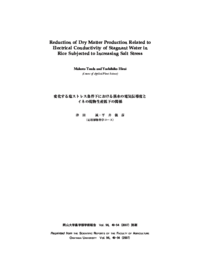

Scientific Reports of the Faculty of Agriculture, Okayama University
Published by the Faculty of Agriculture, Okayama UniversityONLINE ISSN : 2186-7755
Permalink : http://escholarship.lib.okayama-u.ac.jp/9509
変化する塩ストレス条件下における湛水の電気伝導度とイネの乾物生産低下の関係
Published Date
2007-02
Abstract
Knowledge about the relationships between the intensity of salinity of rooting medium and dry matter production may contribute to the improvement of rice yield under saline conditions. A rice cultivar Koshihikari was grown in pots with soils under submerged soil conditions. The stagnant water was salinized with NaCl from 31, 45 and 59 days after sowing, and for each of those, the level of salinity was increased every 6 days to maturity at three different rates of increase. Electrical conductivity (EC) of stagnant water was measured. Final dry weight of above ground parts and panicles decreased as initiation of salinization took place earlier and the rate of increase of EC was higher. Reduction in panicle dry weight was correlated with the occurrence
of white heads. The values of EC at which plants died increased with the plant development and the rate of increase of EC, while these depended mainly on the rate of increase of EC but not on the time of salinization. In the plants which survived after heading, the final dry weight decreased in proportion to accumulated EC (sum of EC values for each day until harvest). Therefore, except for strong salinity where plants may die before heading, accumulated EC should be abe to predict dry matter production under salinity as an integrated indicator of level and duration of salinity.
Keywords
Accumulated EC
Electrical conductivity
White head
ISSN
0474-0254
NCID
AN00033029
